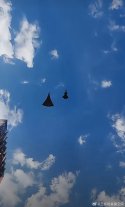I think discourse about the need to always stay in cooperation with CCAs has probably been influenced too much by US doctrines, which is not a negative indictment towards anyone for talking about it, because US is by far the loudest talking about 6th gen air combat. So it's natural that they affect the discourse a lot.
However, what US says are controlled by their practical limitations. They are in the 6th gen CCA/MUMT race but so far not shown that they have progressed far in the 6th gen aerodynamics race.
A mach 2.5+ supercruising combat aircraft does not have to be constrained in the back line or always surrounded by CCAs. In fact, not operating solo can hold it back in an air war because it is surrounded by more easily detectable targets and the enemy can infer it's position based on nearby CCAs/5th gen.
In an air battle, J-36 could operate alone, penetrate the contact line unseen and position itself on the flanks of the enemy main air formation. From there, it would exploit the non-all aspect stealth of adversary 5th gens and cue in fire from J-20/35s in the main friendly air formation confronting the enemy head on, giving the first look at first shoot advantage.
The J-36 would not even need to fire a shot by itself and risk revealing it's position. Alternatively, it would join in on the chase after the initial volley sends the enemy formation running back to friendly airspace, using its massive speed to catch low supercruising 5th gens trying to escape combat.
This isn't something a B-21 can do.
That's how I see it too. Until new supersonic stealth drones with the range, stealth, and speed to follow the j36. It will drag down the j36.
Someone else replied that drones can go fly first which j36 later catches up. But it still means the speed advantage is not fully utilized as the initiative is slower for the planning must be done earlier before to compensate for their slower speed.
J20S with twin seat and the shengad can be flying with cca but I imagine j36 will be flying solo or with other j36 doing deep strike, target cueing, and flanking, and then dash out to refuel and rearm to repeat.



